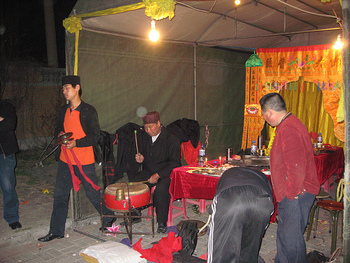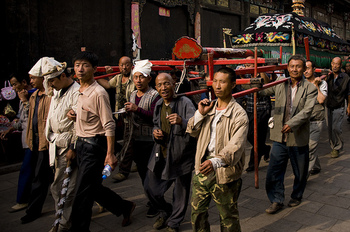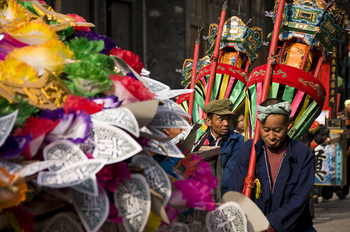Chinese Funeral
Chinese funeral has several main traditions. There are Buddhist ceremonies that last at least for 49 days. First 7 days are believed to be the most important. Prayers are said every 7 days for 49 days. If a family of the deceased is poor this period can be short, lasting for only 3 days.
Traditionally the daughters of the deceased pay the funeral costs. The head of the family should at least be present at first prayer ceremony, if possible at second prayer ceremony and certainly at the burial or cremation.
Chinese also have a special prayer ceremony held every 10 days. This ceremony includes the Buddhist ceremony and 3 succeeding periods of ten days until the burial or cremation.
A final ceremony may be organized 100 days after death. But, for most Chinese it is not so important.
The age of the deceased, the cause of death, the fact that the deceased was single or married, the social status of the deceased are all factors that influence Chinese death rites. The whole procedure of the funeral and everything around should be done in a proper way. Any irregularities can cause bad luck and accidents in the family of the deceased.
Preparations for the funeral start when a person is gravely ill. First, a family orders traditional Asian coffin. The shape of such a coffin is rectangular with three "humps". It has to be mentioned that nowadays western style coffins are becoming more popular.
If the deceased is a father his eldest son is becoming a head of the family. And in case the eldest son dies his role is taken by the second son of the family. His duties among others include relations with the family ancestors.
When someone in the family dies all statues of Chinese gods in the home are covered with red paper. All mirrors are removed. It is done according to the belief that if some person sees a reflection of a coffin in the mirror yet another death would happen in the family very soon. A piece of white cloth is put over a doorway.
There is one more detail. If the deceased is a man people put a gong to the left of the entrance. And if the deceased is a woman a gong is put on the right side.
Body of the deceased is cleaned with a damp towel with some talcum powder applied on it. Then the deceased is dressed in the finest clothes. Such clothes are usually white, black, blue or brown.
Only one colour is forbidden. It is red. Why? Chinese believe that if the deceased would be dressed in red he/she will be become a ghost. All other clothes that the deceased used to wear when he/she was alive are burned.
Then the face of the deceased is covered with a yellow cloth. The body is covered with a light blue cloth. After that the body is put in the coffin.
The wake is what follows. If the deceased died at home the coffin will also be there. But, if he/she died out of home than the coffin will be placed in the courtyard. There are rules considering the position of the coffin. The coffin is put on two stools with a head of the deceased positioned towards the house.
During the wake people do not wear jewellery that includes red objects. Traditionally children and grandchildren of the deceased would not cut their hair for 49 days after the death. This tradition is not so common anymore.
After the wake family members gather around the coffin. Here persons are positioned according to rules.
The colour of clothes worn is also very important. Children and daughters-in-law wear black. Black symbolized the strongest sadness. Grandchildren wear blue clothes and grand grandchildren, if there are any, wear light blue clothes. Sons-in-law wear white or of similar colour. The children and daughters-in-law of the deceased will also wear a sackcloth hood on their head.
The eldest son is suppose to sit at the left shoulder of his parent's coffin and the spouse of the deceased sits on the right. Traditionally those relatives who arrive later are crawling on their knees towards the coffin.
At the foot of the coffin the family prepares an altar. A burning incense and lit white candle are put on such an altar. The Chinese believe that the deceased should have kind of income during his afterlife. That is why during the wake people burn joss paper and prayer money.
Everyone present at the wake burns an incense and bows as a sign of respect for the deceased. There is also a donation box where people put some money as a sign of respect and help for the family. The costs of funerals are quite high.
 Chinese wake
Chinese wake
The following tradition is also held at the wake in China. In the courtyard of the home that used to belong to the deceased there are usually some people gambling. Yes, you read right. This gambling is organized for those who are “guarding” the body of the deceased. It helps them to stay awake during the vigil. Gambling is also suppose to offer some comfort to those present at the wake.
The wake usually lasts for a day. During the wake a monk chants parts of Buddhist or Taoist scriptures. All these prayer, chants and offerings should help the deceased to reach the heaven. Some music with gong, flute or trumpet is performed.
When everything is over the coffin is closed. Then a yellow and white “holy” paper is placed on coffin. This paper should protect the body from dangerous spirits. The whole ritual of closing the coffin has some rules. People should never watch it as it brings bad luck.
A piece of wood is tied over the coffin. It is used for carrying the coffin. People who carry the coffin are believed to be blessed. The coffin is first carried to the road next to the house. More prayers are offered and some paper scattered.
 Chinese funeral procession
Chinese funeral procession
The coffin is then put on a funeral vehicle which will take the coffin to the place of burial. The eldest son and the family are just behind it. If there are many relatives a piece of white cloth is used to connect family to the funeral vehicle.
A long, lit joss stick is carried during the funeral procession. This stick is a symbol of the soul. Paper figures of cars, ships or other objects are sometimes carried as symbols of family wealth. There is a belief that the deceased must be informed whenever the coffin passes over water.
 Chinese funeral procession
Chinese funeral procession
Chinese cemeteries are usually located on a hillside. Why? Well, this is very good according to the Feng shui practice. When the coffin is removed from the funeral vehicle and put into the grave site everyone should turn away. When the coffin is in the grave everyone will throw a handful of soil on the coffin.
When the burial is over. The cemetery keeper will also offer some prayers. The eldest son of the family will then take little bit of soil from the grave and put it into an incense holder. After returning home the family will use an ancestral tablet to worship the deceased.
Everyone present at the funeral will get a little red packet with some money. This packet is a sign of gratitude from the family of the deceased.
Family members wear a piece of cloth on their sleeve for 100 days to show that they are mourning. The colour of this cloth differs. The children of the deceased wear a black cloth. Grandchildren wear blue and grand grandchildren wear a green cloth. This 100 days period of mourning is not observed if the deceased is a child or a wife.
 Chinese gravestone
Chinese gravestone
Let's mention two more of Chinese traditions that are held when someone dies. A special red plaque with some inscription on it is put outside the house. Why? People in China believe that 7 days after death the soul of the deceased will return to his/her home. And for the soul not to get lost this plaque is put.
On the seventh day everyone in the family will stay in their rooms. The floor of the entrance hall is sprinkled with little bit of flour or talcum power. This should show if the soul of the deceased has visited the house or not.
According to a Chinese tradition parents are not suppose to offer prayers for their dead child. Such funerals are performed in silence.